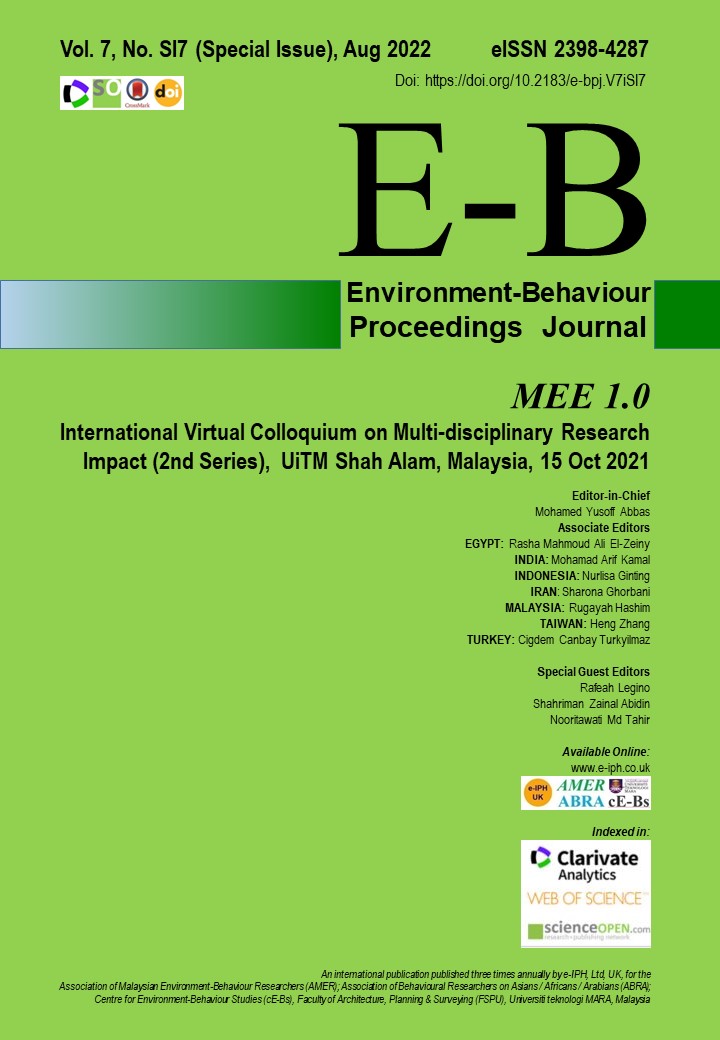Museum as a Laboratory of Knowledge towards Local Culture Empowerment
DOI:
https://doi.org/10.21834/ebpj.v7iSI7.3793Keywords:
Museums, Knowledge Lab, Culture, EmpowermentAbstract
This paper aims to investigate museums' roles that reflect the culture of Malaysia. It discusses Malaysian museums' challenges in meeting audience needs and enhancing the local culture. The four main topics covered are the museum as an informal learning institution, knowledge lab in a museum environment, the crucial role of museums in preserving and empowering culture, and museum impact on local communities. The main objective of this research is to identify how museums act as a knowledge lab within Malaysian culture. The findings of this study are based on observation and discussions with several local museum professionals.
References
Ab Samad Kechot (2010). Proses Pendidikan Muzium: Satu Kajian Awal. Jurnal Melayu (5), h. 285-293.
Bille, T & Olsen, F. (2018). Measuring the quality and impact of arts and culture. In Contested Quality: Negotiating Value in Art and Culture. Norway: Fagbokforlaget
Borg, W.R. and Gall, M.D. (1989) Educational research: An introduction. New York: Longman
Culture and Local Development: Maximising the impact – Guide for Local Governments, Communities, and Museums – ICOM (2018) OECD https://www.oecd.org/cfe/leed/venice-2018-conference-culture/documents/OECD-ICOM-GUIDE-MUSEUMS-AND-CITIES.pdf
Evans, M. (2001). Renaissance in the regions: A new vision for England's museums. London: Resource: The Council for Museums Archives and Libraries.
Harvey, A. (2014, July). Creating learning experiences through interactive devices. Journal of Museum Education, 39(2),pp. 207-215.
Hudson, K.(1976, March). Learning stations, customized worksheets and exhibits effectiveness: The new museum jargon.Museum Journal,75(4),pp. 165-166.
Kelly, L (2006) Measuring the impact of museums on their communities: The role of the 21st century museum – https://www.researchgate.net/publication/253800241
Matarosso, F. (1997). Use or ornament? The social impact of participation in the arts. Stroud: Comedia.
Muhammad Ainuddin Mustafa. Penerimaan Masyarakat Terhadap Institusi Muzium: Kajian Kes di Muzium Negeri Kelantan. Tesis Kajian Sarjana Muda. 2015. Universiti Malaysia Sarawak.
Persson, P. (2000). Community impact of science centres: Is there any?. Curator (Vol. 43, pp. 9-17).
Przesmitzki, D.D.,& Grenier, R. S.(2008, Spring). Nonformal and informal adult learning in museums. Journal of Museum Education, 33(1),pp.9-22.
Reeves, M. (2002). Measuring the economic and social impact of the arts: A review (pp. 131). London: Arts Council of England.
Roberts, A. (2010). The changing role of information profesionals in museums. Dlm.R. Parry(Ed.),Museums in a digital age(hh. 22-27). New York, NY: Routledge.
Rumi Awano.(2007). Brief pictorical description of new mobile technologies used in cultural institution in japan. Journal of Museum Education, 32(1),pp. 17-26
Sandell, R. (1998). Museums as agents of social inclusion. Museum Management and Curatorship (Vol. 17, pp. 63-74).
Seligmann, T.(2014, Mac). Learning museum: A meeting place for pre-service teachers and museum. Journal of Museum Education, 39(1),42-53
Silverman, F.,& Bartley, B.(2013, July). Who is educating whom? two-way learning in museum/university partnership. Journal of Museum Education, 38(2),pp. 154-163.
Wahiza Abdul Wahid. (2018). Models of Educational Provision in the United Kingdom’s University Museums: Resources for the Development of Malaysian University Museums. (PhD Dissertation) Malaysia: UiTM.
Wang, J.,& Yoon.(2013, October). Scaffolding visitors' learning through labels. Journal of Museum Education,38(3),pp. 320-332.
Willard L.Boyd, Presiden, “Field Museum of Natural History Chicago”, (Oktober 22, 1991)
Downloads
Published
How to Cite
Issue
Section
License
Copyright (c) 2022 Wahiza Abdul Wahid, Mohd Jamil Mat Isa

This work is licensed under a Creative Commons Attribution-NonCommercial-NoDerivatives 4.0 International License.





